Lifestyle
Don't get stuck in an age silo: 6 L.A. friend groups on making intergenerational bonds
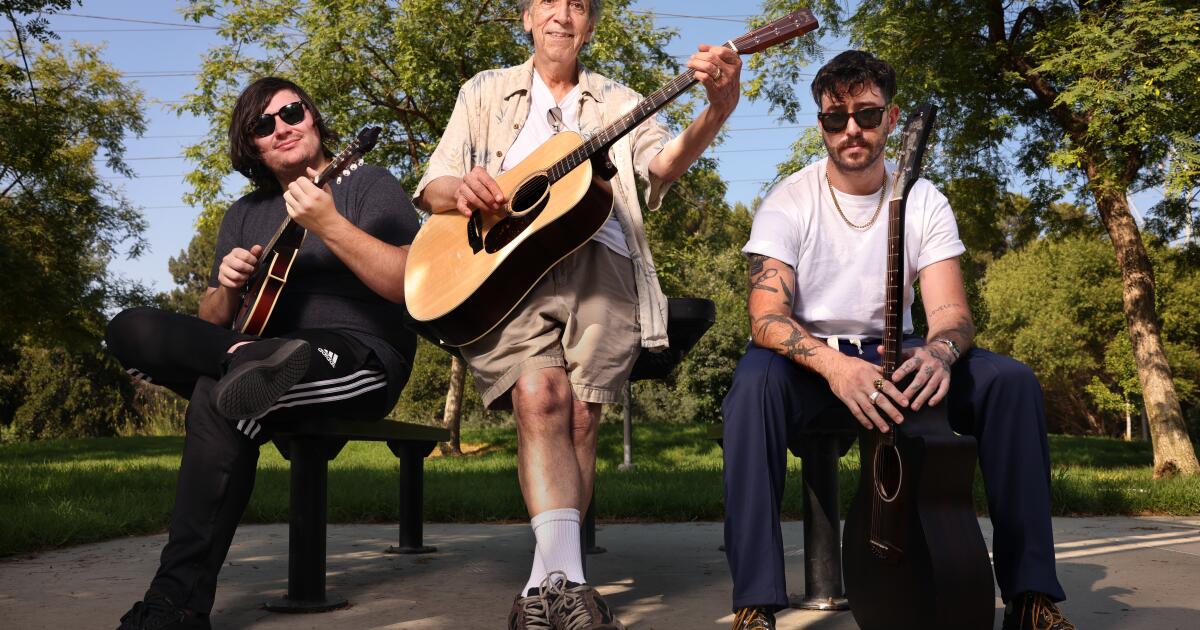
On a bench near the Santa Monica Farmer’s Market in July, Peggy Cheng recalled the time a television writer pitched her a wacky sitcom centered around the unlikely scenario of a young woman who had befriended her elderly neighbors.
Cheng, who was working in TV development at the time, wasn’t impressed.
“She thought it was so unique and I was like, ‘Hmm,’ ” said the 40-year-old Brentwood resident, laughing.
After all, the writer could have been describing Cheng’s life. Her best friend, Karen Lektzian, lives in the unit above hers and is 24 years her senior. They even had a meet-cute: A leaky toilet brought them together. But their difference in age has not stopped the two from being active participants in each other’s lives. Cheng spent months helping Lektzian plan her wedding. Lektzian picked Cheng up from the hospital after surgery. And they’re both always up for a last-minute trip to the local Ralph’s.
“I share everything with her,” Cheng said. “She’s one of the few friends who knows every facet of my life.”
Lektzian, a retired IT consultant, says the feeling is mutual. “Life is more fun when we’re together. I think that sums it up.”
As it turns out, age-gap friendships like Cheng and Lektzian’s may be more common than many of us think. A 2019 AARP survey found that nearly four in 10 adults have a close friend who is at least 15 years older or younger than they are. Even more are interested in cultivating these types of friendships. Nearly eight in 10 adults want to spend more time with people outside their age groups, according to a report from the Washington, D.C.-based organization Generations United.
Although research on the benefits of intergenerational friendships is nascent, several studies suggest that older adults who regularly interact with younger people experience less anxiety, depression and cognitive decline than their more age-siloed peers. For younger folks, having friends outside their generation may help reduce both internal and external ageism, and address feelings of isolation and loneliness.
“From both sides there are individual level benefits that have the potential to improve health and well-being,” said Lauren Dunning, director of future of aging at the Milken Institute.
But ask those who are in age-gap friendships what they like about it, and chances are they’ll simply tell you they are in it for the enjoyment and pleasure of spending time with someone who “gets” them.
“There’s this exchange of ideas and knowledge, and this recognition that having fun is just as much a part of later life as it is for younger life,” said Catherine Elliott O’Dare, a professor in social policy at Trinity College in Dublin who studies the benefits of intergenerational friendships.
We spoke to six intergenerational friend groups in L.A. about how they met, what they do together and the benefits of their age difference.
Friends Justin Beverly, 26, Jose Bautista, 73, and Nicholas Baraban, 33, hang out at Johnny Carson Park in Burbank.
(Christina House / Los Angeles Times)
Justin Beverly, 26, student. Jose Bautista, 73, retail worker. Nicholas Baraban, 33, retail worker
How did you meet?
Bautista: “We all used to work at the Hobby Lobby and these guys used to have beers after work. One day I invited myself along, but on one condition — we have to play [music].”
Favorite activities:
Playing music, going to the batting cage, open mic nights, barbecues.
What makes the friendship special?
Baraban: “I had a best friend who passed away — a bandmate. Jose helped me start playing with other people again. He was the first person I opened up to about playing out again.”
Bautista: “We’ve become best friends. I can rely on these guys for anything and I know they’ll come through. And me too. They can count on me for anything.”
Best part of being in an age-gap friendship?
Beverly: “Getting everyone’s perspective and point of view. People have more stories to tell from different times. It gives an interesting dynamic.”
Bautista: “I don’t feel an age difference with them. I don’t know how a 73-year-old is supposed to act.”
Baraban: “I don’t feel an age difference so much.”
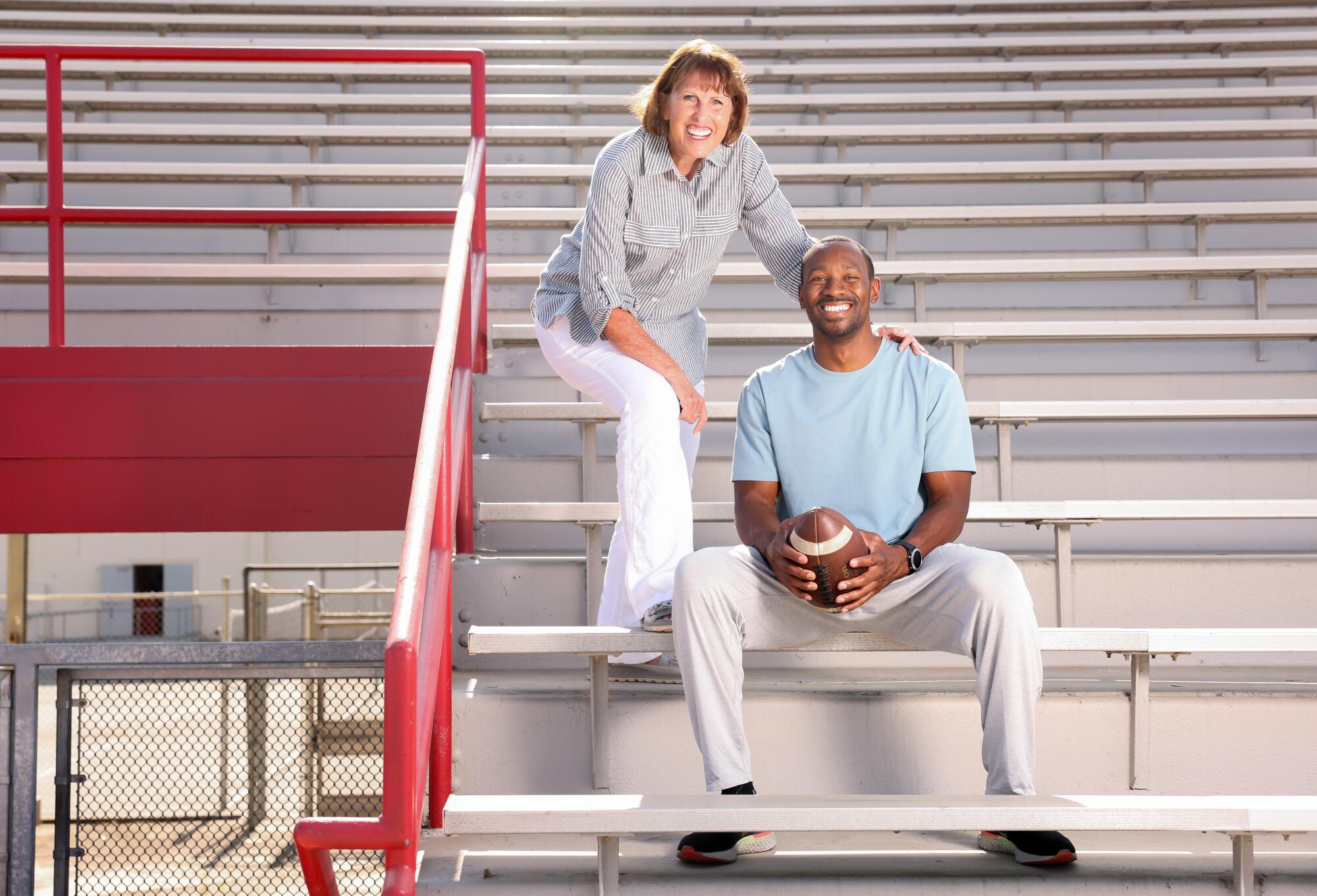
Friends Jeannine Ball, 69, left, and Antoine Cason, 38, sit in the bleachers of Lakewood High School’s football stadium in Lakewood.
(Christina House / Los Angeles Times)
How did you meet?
Ball: “My son Josh was a waterboy for the football team at Los Alamitos High. Antoine walked past us before school one morning and says, ‘Hey J-Dub. How are you doing?’ I said, ‘Who was that?’ and he said, ‘That’s the nicest guy on the football team.”
Cason: “Then I took your photography class senior year and after I went to college I’d come back and see everyone and it just grew from there.”
Favorite activities:
Football activities, going to dinner, and spending time with mutual friends and each other’s families.
What makes the friendship special?
Ball: “He inspires me every time I see him. He lifts up people around him, his personality obviously, but also he cares about people. He gives back.”
Cason: “Every time I’m around her I feel the genuine love and care. She really cares. Sometimes you don’t feel that way around people. And my family loves her too.”
Best part of being in an age-gap friendship?
Ball: “I want to stay relevant for every day of my life. He helps me do that. And it’s not just the age difference. He is a different color than I am, a different culture. I love understanding that better. I can’t say I understand it totally but hopefully it makes me communicate better with everyone as a result of that.”
Cason: “For me — especially where I’ve been, what I’ve done — I feel safe with her. I like to stay as private as I can because everything I’ve done has been in the public. And I just feel safe. That’s very important.”
For the record:
9:49 a.m. Aug. 21, 2024An earlier version of this article misidentified an interview subject as Jeannine Bell, and Antoine Cason as a former NFL quarterback. Her name is Jeannine Ball and Cason is a former NFL cornerback.
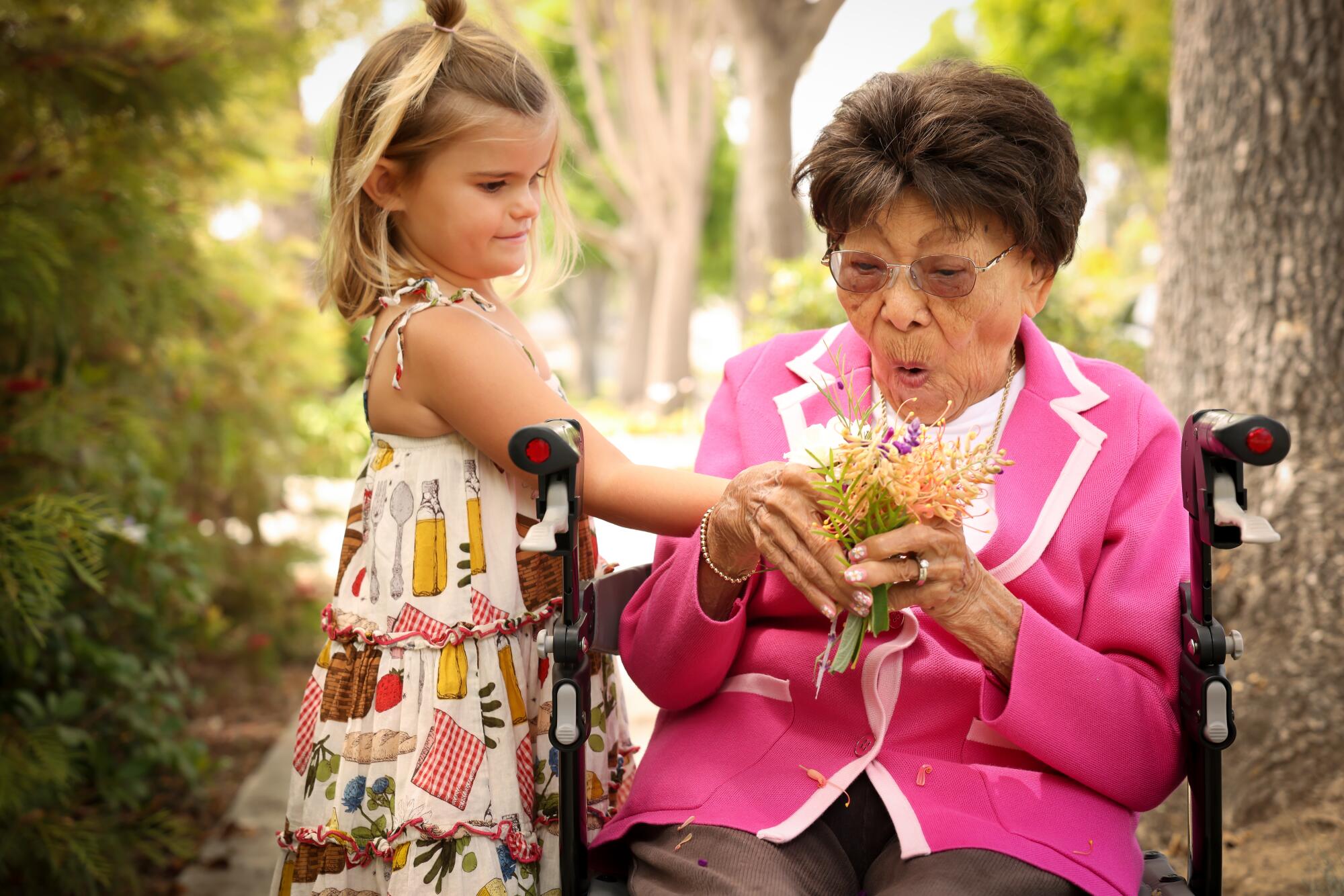
Flora Grewe, 4 1/2, hands her friend Mary Ota, 105, a handful of flowers in Carpinteria.
(Christina House / Los Angeles Times)
Flora Grewe, 4 ½, student. Mary Ota, 105, retired medical office worker
How did you meet?
Ota: “Flora and her family lived at the end of the street where I used to go for a walk. I would sit on my walker and rest before turning around and she would come and bring me flowers. Then she started coming over and we just became friends. Now we get together a lot.”
Favorite activities:
Doing puzzles, getting matching manicures, giving presents.
What makes the friendship special?
Ota: “She is a sweet little girl, always smiling and just adorable. At first she was quite shy, but what was adorable is she would write notes and bring them to me. She would always smile when she brought me things, and even if they were just weeds, I would put them in water.”
Grewe: “I don’t even know! I just like her!”
Best part of being in an age-gap friendship?
Ota: “A friend like Flora keeps things lively. Young people are so full of life. And connecting with young people makes you recall when you were young and your children were young.”
Grewe: “She let me have two cupcakes at her birthday party. She’s nice.”
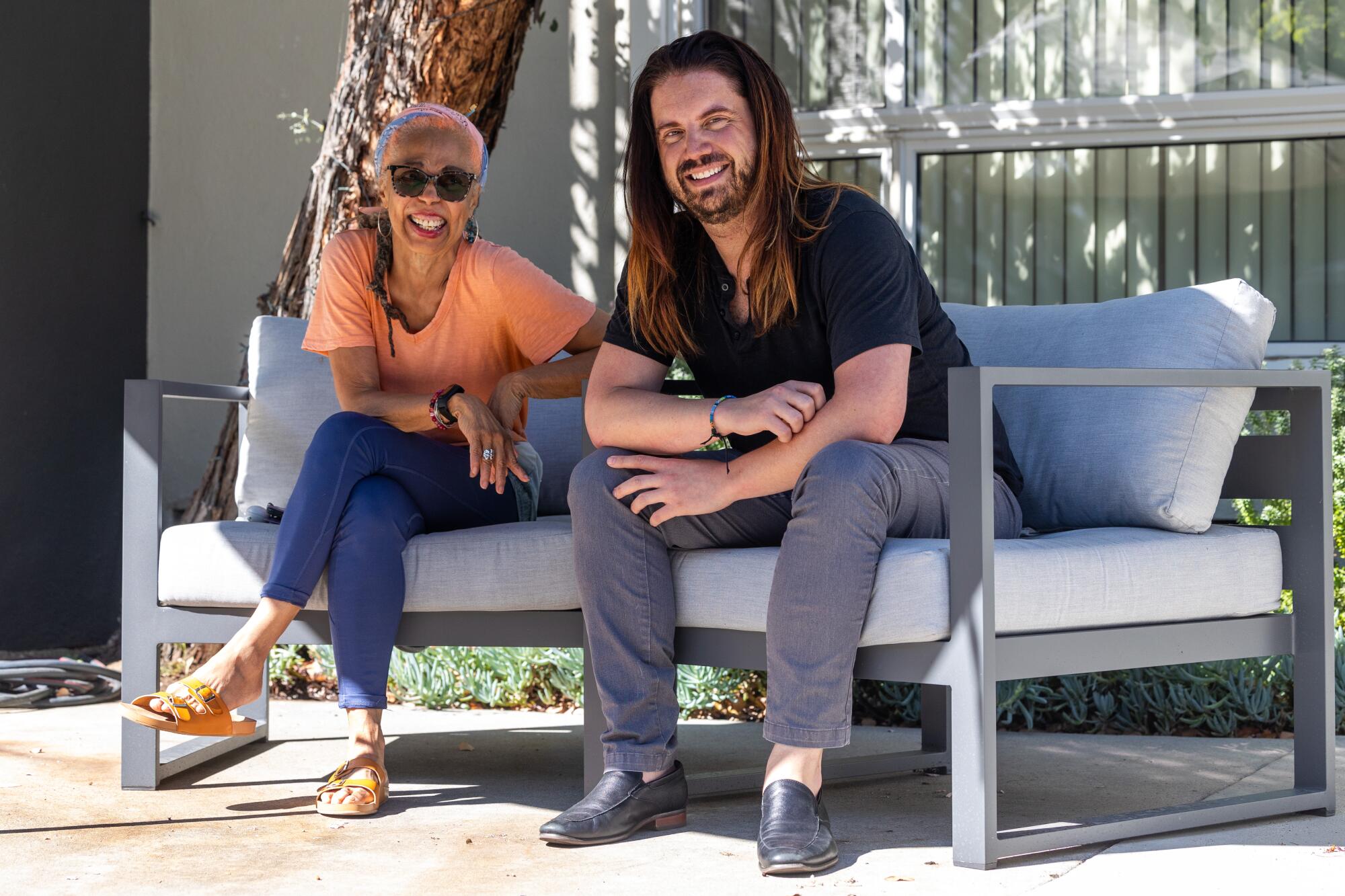
Patricia Smith, 74, and Adam Fowler, 43, sit outside Patricia’s apartment.
(Zoe Cranfill / Los Angeles Times)
patricia smith 73, retired faculty support at UCLA, yoga teacher. Adam Fowler, 43, consultant
How did you meet?
Fowler: “I took a position in Global Economics and Management at UCLA while I was applying to PhD programs. The first day the person I was replacing warned me about the woman down the hall. I hadn’t been in Los Angeles terribly long and I was like, ‘Oh, God, I hope this isn’t a nightmare.’ But we just hit it off.”
smith: “He endeared me to him with the ‘Yes, ma’am.’ It reminded me of the way I was brought up. And his Southern accent was the cutest thing in the world.”
Favorite activities:
Picnics at the Hollywood Bowl, movie nights at Hollywood Forever Cemetery, talking on the phone, fixing up smith’s apartment.
What makes the friendship special?
Fowler: “She made it comfortable to grow as a human. I was from the boonies of Arkansas, trying to figure out who I was in terms of coming out as gay, pursuing a PhD from a family where I was already the first generation of college students, and this was a person who was so secure in who she was and kind and generous.”
smith: “He was always so freaking smart, but he was smart without being arrogant. That was one of the more endearing qualities I recognized in him right away.”
Best part of being in an age- gap friendship?
smith: “He helps me to stay young. He turns me onto stuff. When I don’t know what’s going on, I just call him and he sets me straight. He helps me to pay attention — not to mention that he does [stuff] for me. That’s priceless.”
Fowler: “It’s such a source of context and wisdom. Whenever you get spun up on something small in your own life, patricia can either help you laugh about it or put it in some broader context. And just everything she’s done, moving here from Chicago, things she’s been through, all of that is so very interesting. I’d say it’s the resilience for me.”
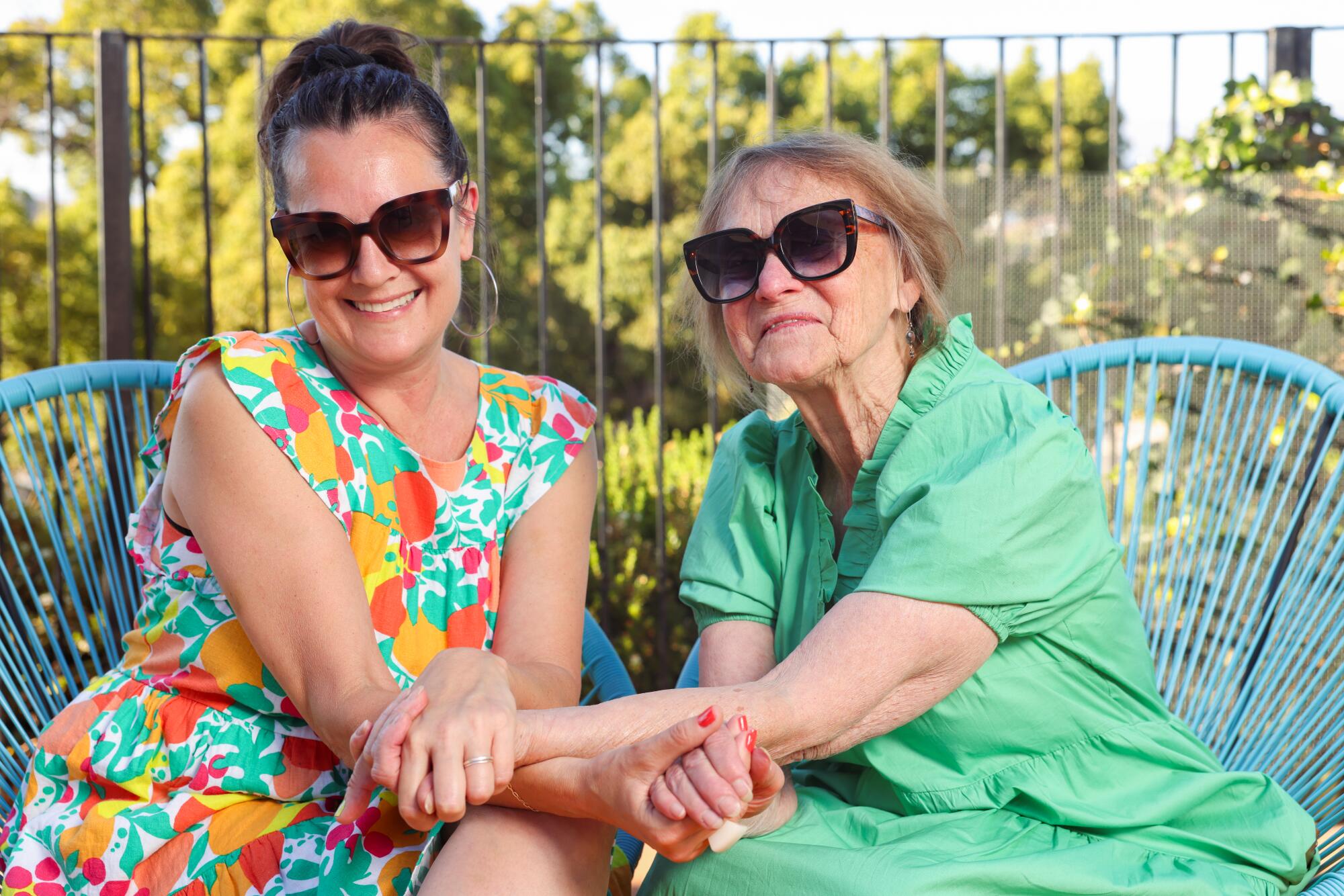
Marlo Wamsganz, left, 54, and Norma Hench, right, 83, have been friends for years. The pair like to swap books, plant clippings, hike and visit botanic gardens.
(Dania Maxwell / Los Angeles Times)
Marlo Wamsganz, 54, designer. Norma Hench, 83, retired teacher
How did you meet?
Wamsganz: “We were both living in Vermont and I was dating her partner Glenn’s son. The first time we met we were already walking around her gardens. Then I moved on from that relationship and Glenn passed away. We lost touch, not because we didn’t love each other, but because life goes on. “
Hench: “It took me a full year to get my act together after Glenn died and move to L.A. where my son lives. I flew from Vermont to JFK and, lo and behold, there’s Marlo!”
Wamsganz: “We were both relocating to L.A. and when we got on the plane I believe we were in the same row. I thought, ‘This is wild.’ ”
Favorite activities:
Visiting botanic gardens, trying new foods, hiking in Malibu, visiting museums and swapping books.
What makes the friendship special?
Wamsganz: “Norma loves to learn new things, she’s up for anything, she’ll taste anything, and she also likes to dig deep into things. I love how positive she is and she speaks her mind. She’s very fair and believes in rights for all people. And she’s a great conversationalist.”
Hench: “I want to tell a story: We were crossing Ventura Boulevard — this big multi lane street, and right in the middle of the crosswalk there was a praying mantis. And without missing a beat, didn’t Marlo reach down and pick up this praying mantis and carry it with her across to the other side of the street and put it on the lawn? Now, doesn’t that speak volumes?”
Best part of being in an age-gap friendship?
Hench: “I never think about an age difference. I’m not even aware of that. Maybe I’m in denial.”
Wamsganz: “I don’t either. Although I do ask her some things. Like, how long do hot flashes go on?”

Friends Peggy Cheng, 40, left, and Karen Lektzian, 64, shop at the Santa Monica Farmer’s Market.
(Christina House / Los Angeles Times)
Peggy Cheng, 40, entrepreneur. Karen Lektzian, 64, retired IT consultant
How did you meet?
Cheng: “Her master toilet flooded my unit, and it was easier to go through my unit to fix it. I was working really long hours at that time, so I was just like, ‘Yup! OK! Bye!’ She was like, ‘Can I get you any gift cards or a dinner?’ and I was just like, ‘No! I don’t really expect to interact with you.’ ”
Lektzian: “The remediation took three weeks, and over the course of those three weeks we had quite a few interactions, so we got to know each other a little bit. I invited her to dinner and with the proximity we started to run into each other more often and it was so easy to just say, ‘Want to pop up for a drink? Or, do you want to cook dinner tonight?’ ”
Favorite activities?
Traveling, cooking, eating out, running errands.
What makes the friendship special?
Lektzian: “We just have so much fun together. It doesn’t matter what we’re doing. And we have so many common interests. It’s just so natural. Life is more fun with her.”
Cheng: “I like that I can share everything with her. She’s one of the few friends who knows every facet of my life. I can go to her for advice and if it’s serious she will just switch into that mode and then immediately we will have the giggles.”
What is the best part of being in an age-gap friendship?
Lektzian: “I don’t really notice when I’m with my friends my own age versus Peggy.”
Cheng: “I don’t feel it either. She’s equally energetic and way more fit than I am!”

Lifestyle
10 books we’re looking forward to in early 2026

Two fiction books about good friends coming from different circumstances. Two biographies of people whose influence on American culture is, arguably, still underrated. One Liza Minnelli memoir. These are just a handful of books coming out in the first few months of 2026 that we’ve got our eye on.
Fiction

Autobiography of Cotton, by Cristina Rivera Garza, Feb. 3
Garza, who won a Pulitzer in 2024 for memoir/autobiography, actually first published Autobiography of Cotton back in 2020, but it’s only now getting an English translation. The book blends fiction with the author’s own familial history to tell the story of cotton cultivation along the U.S.-Mexico border.

Crux, by Gabriel Tallent, Jan. 20
Tallent’s last novel, My Absolute Darling, was a harrowing coming of age story about a teenage girl surviving her abusive survivalist father. But it did find pockets of beauty in the outdoors. Tallent’s follow up looks to be similarly awestruck by nature. It’s about two young friends, separated by class and opportunity, but bound together by a love of rock climbing.

Half His Age, by Jennette McCurdy, Jan. 20
The former iCarly actress’ bracing and brutally honest memoir, I’m Glad My Mom Died, was a huge hit. It spent weeks on bestseller’s lists, and is being adapted into a series for Apple TV+. Now McCurdy’s set to come out with her fiction debut, about a teenage girl who falls for her high school creative writing teacher.

Kin, by Tayari Jones, Feb. 24
Similarly to Crux, Kin also follows two friends across the years as options and opportunities pull them apart. The friends at the center of this book are two women who grew up without moms. Jones’ last novel, 2018’s An American Marriage, was a huge hit with critics.

Seasons of Glass & Iron: Stories, by Amal El-Mohtar, March 24
El-Mohtar is an acclaimed science-fiction writer, and this book is a collection of previously published short stories and poetry. Many of the works here have been honored by the big science-fiction/fantasy awards, including the titular story, which is a feminist re-telling of two fairy tales.
Nonfiction

A Hymn to Life: Shame Has to Change Sides, by Gisèle Pelicot, Feb. 17
Pelicot’s story of rape and sexual assault – and her decision to wave anonymity in the trial – turned her into a galvanizing figure for women across the world. Her writing her own story of everything that happened is also a call to action for others to do the same.

Cosmic Music: The Life, Art, and Transcendence of Alice Coltrane, by Andy Beta, March 3
For decades, the life and work of Alice Coltrane has lived in the shadow of her husband, John Coltrane. This deeply researched biography hopes to properly contextualize her as one of the most visionary and influential musicians of her time.

Football, by Chuck Klosterman, Jan. 20
One of our great essaysists and (over?) thinkers turns his sights onto one of the last bits of monoculture we’ve got. But in one of the pieces in this collection, Klosterman wonders, how long until football is no longer the summation of American culture? But until that time comes, there’s plenty to dig into from gambling to debates over the true goat.

Kids, Wait Till You Hear This! by Liza Minnelli, with Michael Feinstein, March 20
Minnelli told People that previous attempts at telling her story “didn’t get it right,” so she’s doing it herself. This new memoir promises to get into her childhood, her marriages, and her struggles with substance abuse.

Tom Paine’s War: The Words that Rallied a Nation and the Founder of Our Time, by Jack Kelly, Jan. 6
If you haven’t heard, it’s a big birthday year for America. And it’s a birthday that might not have happened if not for the words of Thomas Paine. This new book from historian Jack Kelly makes the argument that Paine’s words are just as important and relevant to us today.
Lifestyle
At 70, she embraced her Chumash roots and helped revive a dying skill

Around 1915, the last known Chumash basket maker, Candelaria Valenzuela, died in Ventura County, and with her went a skill that had been fundamental to the Indigenous people who lived for thousands of years in the coastal regions between Malibu and San Luis Obispo.
A century and two years later, 70-year-old Santa Barbara native Susanne Hammel-Sawyer took a class out of curiosity to learn something about her ancestors’ basket-making skills.
Hammel-Sawyer is 1/16 Chumash, the great-great-great-granddaughter of Maria Ysidora del Refugio Solares, one of the most revered ancestors of the Santa Ynez Band of Chumash Indians for her work in preserving its nearly lost Samala language.
But Hammel-Sawyer knew nearly nothing about Chumash customs when she was a child. As a young mother, she often took her four children to the Santa Barbara Museum of Natural History, where she said she loved to admire the museum’s extensive collection of Chumash baskets, “but I had no inkling I would ever make them.”
Nonetheless, today, at age 78, Hammel-Sawyer is considered one of the Santa Ynez Band’s premier basket makers, with samples of her work on display at three California museums.
Short, reddish brown sticks of dried basket rush sit in a small basket in Susanne Hammel-Sawyer’s kitchen, waiting to be woven into one of her baskets. The reddish color only appears at the bottom ends of the reeds, after they dry, so she saves every inch to create designs in her baskets. “These are my gold,” she says.
(Sara Prince / For The Times)
She grows the basket rush (Juncus textilis) reeds that make up the weaving threads of her baskets in a huge galvanized steel water trough outside her Goleta home and searches in the nearby hills for other reeds: primarily Baltic rush (Juncus balticus) to form the bones or foundation of the basket and skunk bush (Rhus aromatica var. trilobata) to add white accents to her designs.
All her basket materials are gathered from nature, and her tools are simple household objects: a large plastic food storage container for soaking her threads and the rusting lid of an old can with different-sized nail holes to strip her reeds to a uniform size. Her baskets are mostly the yellowish brown color of her main thread, strips of basket rush made pliant after soaking in water.
The basket reeds often develop a reddish tint at the bottom part of the plant when they’re drying. “Those are my gold,” she said, because she uses those short ends to add reddish designs. Or sometimes she just weaves them into the main basket for added flair.
The only other colors for the baskets come from skunk bush reeds, which she has to split and peel to reveal the white stems underneath, and some of the basket reeds that she dyes black in a big bucket in her backyard.
“This is my witches’ brew,” she said laughing as she stirred the viscous inky liquid inside the bucket. “We have to make our own from anything with tannin — oak galls, acorns or black walnuts — and let it sit to dye it black.”
Hammel-Sawyer is remarkable not just for her skill as a weaver, but her determination to master techniques that went out of practice for nearly 100 years, said anthropologist and ethnobotanist Jan Timbrook, curator emeritus of ethnography at the Santa Barbara Museum of Natural History, which claims to have the world’s largest museum collection of Chumash baskets.
“Susanne is one of the very few contemporary Chumash people who have truly devoted themselves to becoming skilled weavers,” said Timbrook, author of “Chumash Ethnobotany: Plant Knowledge Among the Chumash People of Southern California.” “Many have said they’d like to learn, but once they try it and realize how much time, patience and practice it requires … they just can’t keep it up.”

Susanne Hammel-Sawyer adds another row to her 35th basket, working from a straight back chair in her small living room, next to a sunny window and the tiny table where she keeps all her supplies.
(Sara Prince / For The Times)
In her eight years, Hammel-Sawyer has made just 34 baskets of various sizes (she’s close to finishing her 35th), but she’s in no hurry.
“People always ask how long it takes to make a basket, and I tell them what Jan Timbrook likes to say, ‘It takes as long as it takes,’” Hammel-Sawyer said. “But for me, it’s a way of slowing down. I really object to how fast we’re all moving now, and it’s only going to get faster.”
She and her husband, Ben Sawyer, have a blended family of five children and nine grandchildren, most of whom live near their cozy home in Goleta. Family activities keep them busy, but Hammel-Sawyer thinks it’s important for her family to know she has other interests too.
“When you’re older, you have to be able to find a passion, something your children and grandchildren can see you do, not just playing golf or going on cruises, but doing something that matters,” she said. “I wish my grandmother and my father knew I was doing this because it’s a connection with our ancestors, but it’s also looking ahead, because these baskets I’m making will last a very long time. It’s something that comes from my past that I’m giving to family members to take into the future, so it’s worth my time.”
Also, this isn’t a business for Hammel-Sawyer. Her baskets are generally not for sale because she only makes them for family and friends, she said. The baskets at the Santa Barbara Museum of Natural History and the Santa Ynez Chumash Museum and Cultural Center belong to family members who were willing to loan them out for display. The Chumash museum does have some of Hammel-Sawyer’s baskets for sale in its gift shop, which she said she reluctantly agreed to provide after much urging, so the store could offer more items made by members of the Band.

For the last eight years, Susanne Hammel-Sawyer has used the same old can lid, punched with nail holes of various sizes, to strip her moistened basket threads to a consistent size.
(Sara Prince / For The Times)
The only other basket she’s sold, she said, was to the Autry Museum of the American West, because she was so impressed by its exhibits involving Indigenous people. “I just believe so strongly in the message the Autry is giving the world about what really happened to Indigenous people, I thought I would be proud to have something there,” she said.
Making a basket takes so long, Hammel-Sawyer said, that it’s important for her to focus on the recipient, “so while I’m making it, I can think about them and pray about them. When you know you’re making a basket for someone, it has so much more meaning. And I’m so utilitarian, I always hope someone will use them.”
For instance, she said, she made three small baskets for the children of a friend and was delighted when one used her basket to carry flower petals to toss during a wedding. Almost any use is fine with her, she said, except storing fruit, because if the fruit molds, the basket will be ruined.
Baskets were a ubiquitous part of Chumash life before the colonists came. They used them for just about everything, from covering their heads and holding their babies to eating and even cooking, Timbrook said. They put hot rocks into their tightly woven baskets, along with food like acorn mush, to bring the contents to boil.
“People think pottery is a higher form of intellectual achievement, but the thing is, baskets are better than pottery,” Timbrook said. “They’ll do anything pottery will do; you can cook in them and store things in them, and when you drop them, they don’t break.”

1. Tule reeds that grows in the yard in preparation of basket weaving. 2. Susanne Hammel-Sawyer weaves a basket. 3. A basket sits during a break in weaving with tools on a table. (Sara Prince / For The Times)
After Hammel-Sawyer’s first marriage ended, she worked as an assistant children’s librarian in Santa Barbara and met a reference librarian named Ben Sawyer. After their friendship turned romantic, they married in 1997 and moved, first to Ashland, Ore., then Portland, and then the foothills of the Sierras in Meadow Valley, Calif., where they took up organic farming for a dozen years.
Meadow Valley’s population was 500, and the big town was nearby Quincy, the county seat, with about 5,000 residents, but it still had an orchestra and she and her husband were both members. She played cello and he viola, not because they were extraordinary musicians, she said, but because “we played well enough, and if we wanted an orchestra, we would have to take part. I loved how strong people were there. We were all more self-sufficient than when we lived in the city.”
The Sawyers moved back to Santa Barbara in 2013, the year after her father died, to help care for her mother, who had developed Alzheimer’s disease. And for the next four years, between caring for her mother, who died in 2016, and the birth of her grandchildren, family became her focus.
But in 2017, the year she turned 70, Hammel-Sawyer finally had the space to begin looking at other activities. Being she’s 1/16 Chumash, she was eligible for classes taught by the Santa Ynez Band. She had seen several class offerings come through over the years, but nothing really captured her interest until she saw a basket-weaving class offered by master basket maker Abe Sanchez, as part of the tribe’s ongoing effort to revive the skill among its members.
Most Chumash baskets have some kind of pattern, although today people have to guess at the meaning of the symbols, Timbrook said. Some look like squiggles, zigzaggy lightning bolts or sun rays, but the wonder, marveled Hammel-Sawyer, is how the makers were able to do the mental math to keep the patterns even and consistent, even for baskets that were basically everyday tools.
Hammel-Sawyer is careful to follow the basics of Chumash weaving, using the same native plants for her materials and weaving techniques that include little ticks of contrasting color stitches on the rim, something visible in most Chumash baskets. She keeps a good supply of bandages for her fingers because the reeds have sharp edges when they’re split, and it’s easy to get the equivalent of paper cuts.
She keeps just two baskets at her house — her first effort, which “wasn’t good enough to give anybody,” she said, laughing — and a basket hat started by her late sister, Sally Hammel.

This basket hat was started by Susanne Hammel-Sawyer’s sister, Sally Hammel, but the stitches became ragged and uneven after Sally began treatment for cancer. She was so distressed by her work, she hid the unfinished basket, but after she died, Hammel-Sawyer found it and brought it home to complete it. It’s one of only two baskets she’s made that she keeps in her home.
(Sara Prince / For The Times)
“Sally was an artist in pottery, singing, acting and living life to the fullest,” Hammel-Sawyer said, and she was very excited to learn basketry. Her basket hat started well, but about a third of the way in, she got cancer “and her stitches became more and more ragged. She had trouble concentrating, trouble preparing materials,” Hammel-Sawyer said. “Everything became so difficult that she hid the basket away. I know she didn’t even want to look at it, let alone have anyone else see it.”
After her sister died in 2020, Hammel-Sawyer had a hard time finding the basket, “but I did, and I asked my teacher what to do, and he said, ‘Just try to make sense of her last row’ … So that’s what I did.” She added a thick black-and-white band above the ragged stitches and finished the blond rim with the traditional contrasting ticking.
The hat rests now above the window in Hammel-Sawyer’s living room, except when she wears it to tribal events.
“Sally and I were very close, and I think she’d just be happy to know it was finished and appreciated,” Hammel-Sawyer said. “Even the hard parts … deeply appreciated.”
Lifestyle
Nick Reiner’s attorney removes himself from case
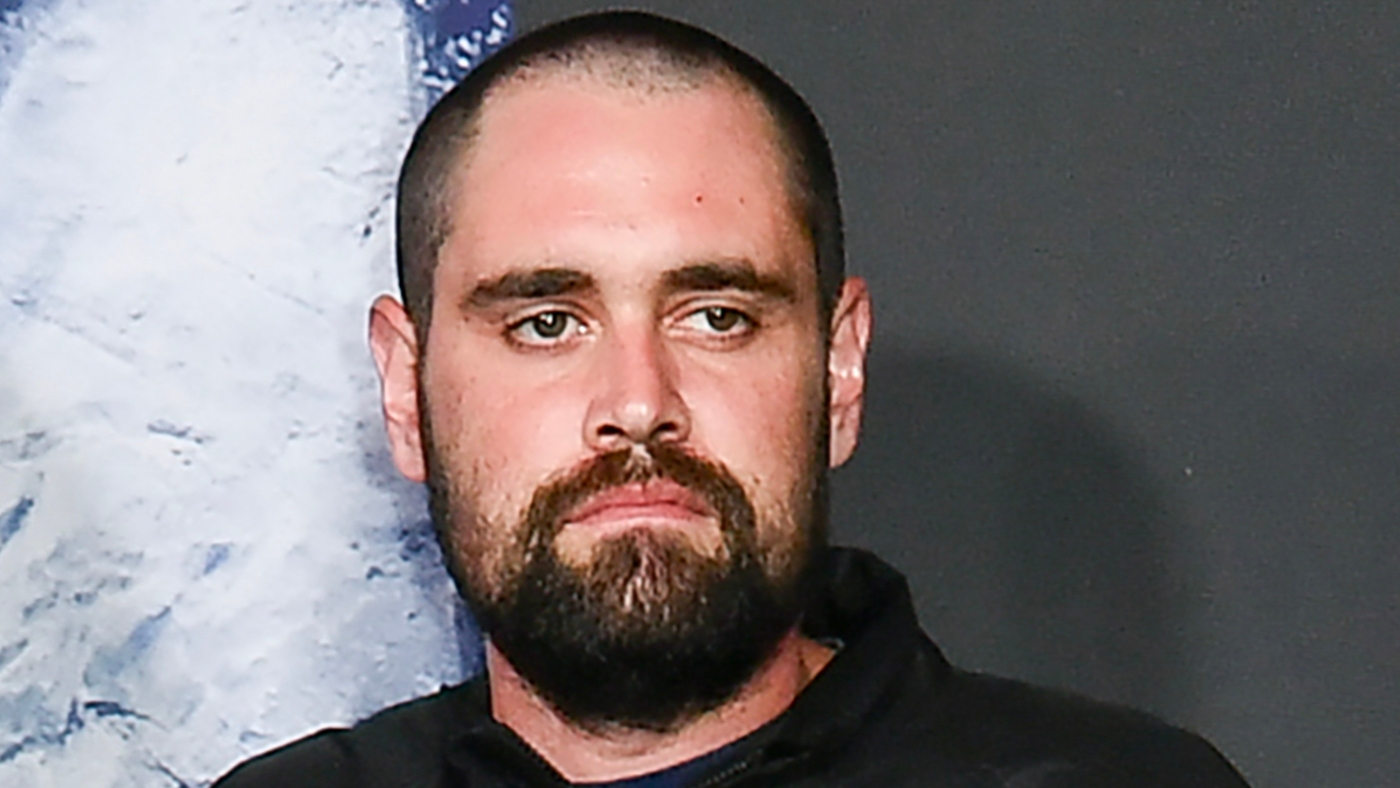
Nick Reiner arrives at the premiere of Spinal Tap II: The End Continues on Tuesday, Sept. 9, 2025, in Los Angeles.
Richard Shotwell/Invision/AP
hide caption
toggle caption
Richard Shotwell/Invision/AP
LOS ANGELES – Alan Jackson, the high-power attorney representing Nick Reiner in the stabbing death of his parents, producer-actor-director Rob Reiner and photographer Michele Singer Reiner, withdrew from the case Wednesday.
Reiner will now be represented by public defender Kimberly Greene.
Wearing a brown jumpsuit, Reiner, 32, didn’t enter a plea during the brief hearing. A judge has rescheduled his arraignment for Feb. 23.
Following the hearing, defense attorney Alan Jackson told a throng of reporters that Reiner is not guilty of murder.
“We’ve investigated this matter top to bottom, back to front. What we’ve learned and you can take this to the bank, is that pursuant to the law of this state, pursuant to the law in California, Nick Reiner is not guilty of murder,” he said.

Reiner is charged with first-degree murder, with special circumstances, in the stabbing deaths of his parents – father Rob, 78, and mother Michele, 70.
The Los Angeles coroner ruled that the two died from injuries inflicted by a knife.
The charges carry a maximum sentence of death. LA County District Attorney Nathan Hochman said he has not decided whether to seek the death penalty.
“We are fully confident that a jury will convict Nick Reiner beyond a reasonable doubt of the brutal murder of his parents — Rob Reiner and Michele Singer Reiner … and do so unanimously,” he said.

Last month, after Reiner’s initial court appearance, Jackson said, “There are very, very complex and serious issues that are associated with this case. These need to be thoroughly but very carefully dealt with and examined and looked at and analyzed. We ask that during this process, you allow the system to move forward – not with a rush to judgment, not with jumping to conclusions.”
The younger Reiner had a long history of substance abuse and attempts at rehabilitation.
His parents had become increasingly alarmed about his behavior in the weeks before the killings.
Legal experts say there is a possibility that Reiner’s legal team could attempt to use an insanity defense.
Defense attorney Dmitry Gorin, a former LA County prosecutor, said claiming insanity or mental impairment presents a major challenge for any defense team.

He told The Los Angeles Times, “The burden of proof is on the defense in an insanity case, and the jury may see the defense as an excuse for committing a serious crime.“
“The jury sets a very high bar on the defendant because it understands that it will release him from legal responsibility,” Gorin added.
The death of Rob Reiner, who first won fame as part of the legendary 1970s sitcom All in the Family, playing the role of Michael “Meathead” Stivic, was a beloved figure in Hollywood and his death sent shockwaves through the community.
After All in the Family, Reiner achieved even more fame as a director of films such as A Few Good Men, Stand By Me, The Princess Bride and When Harry Met Sally. He was nominated for four Golden Globe Awards in the best director category.
Rob Reiner came from a show business pedigree. His father, Carl Reiner, was a legendary pioneer in television who created the iconic 1960s comedy, The Dick Van Dyke Show.
-

 Detroit, MI5 days ago
Detroit, MI5 days ago2 hospitalized after shooting on Lodge Freeway in Detroit
-

 Technology2 days ago
Technology2 days agoPower bank feature creep is out of control
-

 Dallas, TX4 days ago
Dallas, TX4 days agoDefensive coordinator candidates who could improve Cowboys’ brutal secondary in 2026
-

 Health4 days ago
Health4 days agoViral New Year reset routine is helping people adopt healthier habits
-

 Nebraska2 days ago
Nebraska2 days agoOregon State LB transfer Dexter Foster commits to Nebraska
-

 Iowa2 days ago
Iowa2 days agoPat McAfee praises Audi Crooks, plays hype song for Iowa State star
-

 Nebraska2 days ago
Nebraska2 days agoNebraska-based pizza chain Godfather’s Pizza is set to open a new location in Queen Creek
-

 Entertainment1 day ago
Entertainment1 day agoSpotify digs in on podcasts with new Hollywood studios

















